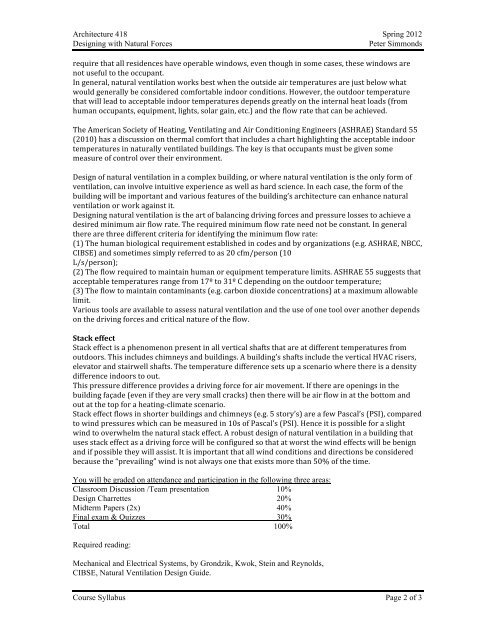Architecture 418 Spring 2012 Designing with Natural Forces Peter ...
Architecture 418 Spring 2012 Designing with Natural Forces Peter ...
Architecture 418 Spring 2012 Designing with Natural Forces Peter ...
Create successful ePaper yourself
Turn your PDF publications into a flip-book with our unique Google optimized e-Paper software.
<strong>Architecture</strong> <strong>418</strong> <strong>Spring</strong> <strong>2012</strong><br />
<strong>Designing</strong> <strong>with</strong> <strong>Natural</strong> <strong>Forces</strong><br />
<strong>Peter</strong> Simmonds<br />
require that all residences have operable windows, even though in some cases, these windows are <br />
not useful to the occupant. <br />
In general, natural ventilation works best when the outside air temperatures are just below what <br />
would generally be considered comfortable indoor conditions. However, the outdoor temperature <br />
that will lead to acceptable indoor temperatures depends greatly on the internal heat loads (from <br />
human occupants, equipment, lights, solar gain, etc.) and the flow rate that can be achieved. <br />
<br />
The American Society of Heating, Ventilating and Air Conditioning Engineers (ASHRAE) Standard 55 <br />
(2010) has a discussion on thermal comfort that includes a chart highlighting the acceptable indoor <br />
temperatures in naturally ventilated buildings. The key is that occupants must be given some <br />
measure of control over their environment. <br />
Design of natural ventilation in a complex building, or where natural ventilation is the only form of <br />
ventilation, can involve intuitive experience as well as hard science. In each case, the form of the <br />
building will be important and various features of the building’s architecture can enhance natural <br />
ventilation or work against it. <br />
<strong>Designing</strong> natural ventilation is the art of balancing driving forces and pressure losses to achieve a <br />
desired minimum air flow rate. The required minimum flow rate need not be constant. In general <br />
there are three different criteria for identifying the minimum flow rate: <br />
(1) The human biological requirement established in codes and by organizations (e.g. ASHRAE, NBCC, <br />
CIBSE) and sometimes simply referred to as 20 cfm/person (10 <br />
L/s/person); <br />
(2) The flow required to maintain human or equipment temperature limits. ASHRAE 55 suggests that <br />
acceptable temperatures range from 17º to 31º C depending on the outdoor temperature; <br />
(3) The flow to maintain contaminants (e.g. carbon dioxide concentrations) at a maximum allowable <br />
limit. <br />
Various tools are available to assess natural ventilation and the use of one tool over another depends <br />
on the driving forces and critical nature of the flow. <br />
<br />
Stack effect<br />
Stack effect is a phenomenon present in all vertical shafts that are at different temperatures from <br />
outdoors. This includes chimneys and buildings. A building’s shafts include the vertical HVAC risers, <br />
elevator and stairwell shafts. The temperature difference sets up a scenario where there is a density <br />
difference indoors to out. <br />
This pressure difference provides a driving force for air movement. If there are openings in the <br />
building façade (even if they are very small cracks) then there will be air flow in at the bottom and <br />
out at the top for a heating‐climate scenario. <br />
Stack effect flows in shorter buildings and chimneys (e.g. 5 story’s) are a few Pascal’s (PSI), compared <br />
to wind pressures which can be measured in 10s of Pascal’s (PSI). Hence it is possible for a slight <br />
wind to overwhelm the natural stack effect. A robust design of natural ventilation in a building that <br />
uses stack effect as a driving force will be configured so that at worst the wind effects will be benign <br />
and if possible they will assist. It is important that all wind conditions and directions be considered <br />
because the “prevailing” wind is not always one that exists more than 50% of the time. <br />
You will be graded on attendance and participation in the following three areas:<br />
Classroom Discussion /Team presentation 10%<br />
Design Charrettes 20%<br />
Midterm Papers (2x) 40%<br />
Final exam & Quizzes 30%<br />
Total 100%<br />
Required reading:<br />
Mechanical and Electrical Systems, by Grondzik, Kwok, Stein and Reynolds,<br />
CIBSE, <strong>Natural</strong> Ventilation Design Guide.<br />
Course Syllabus Page 2 of 3

















